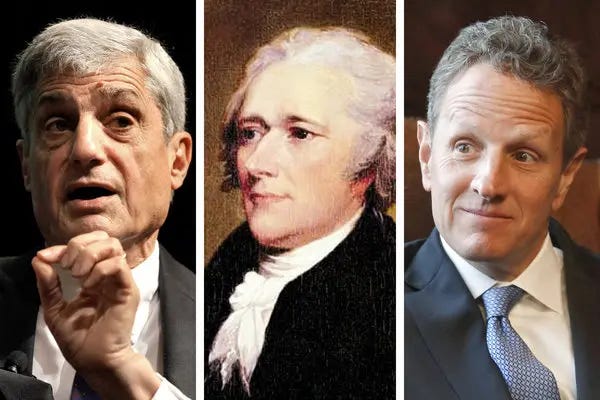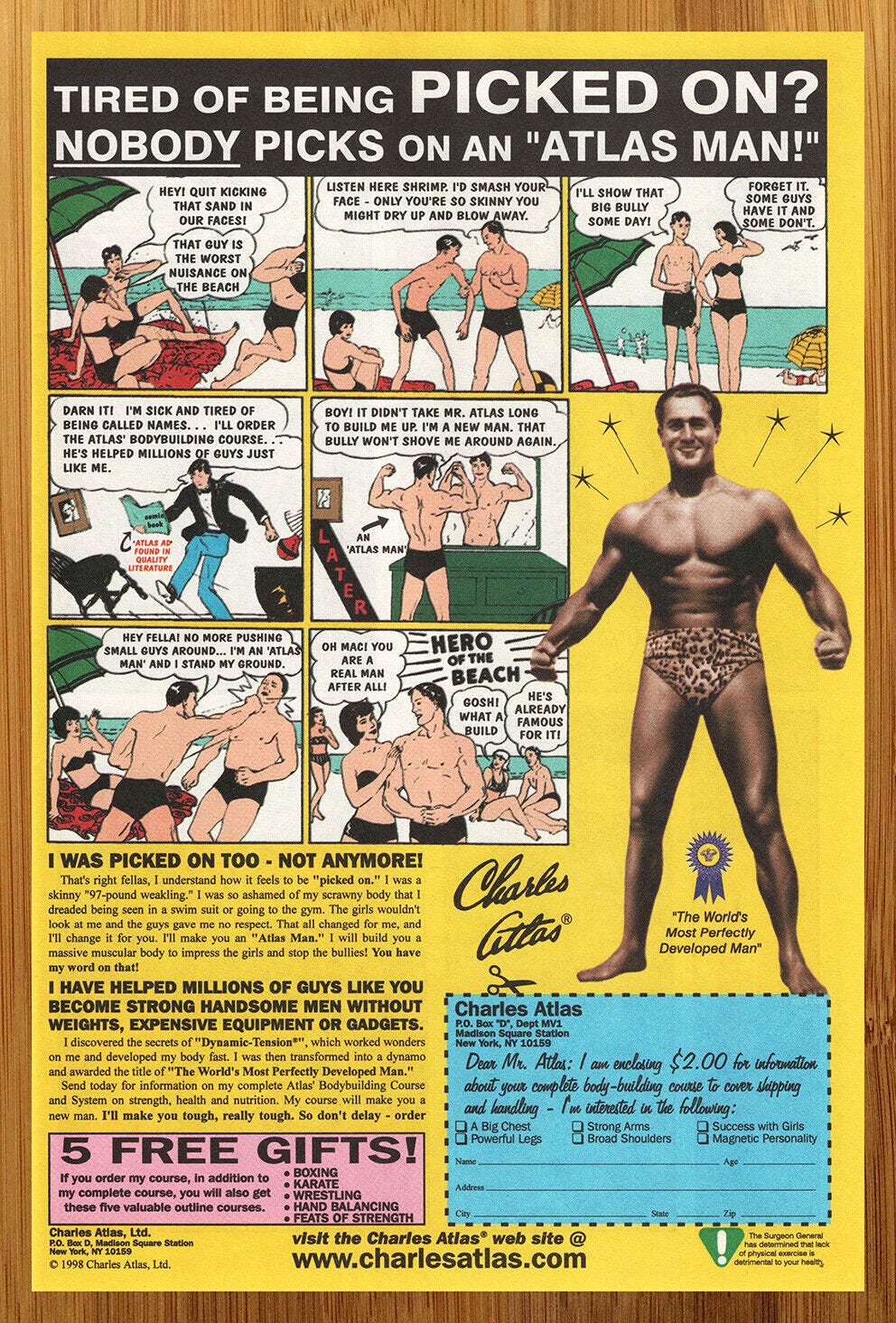TEMPORARILY UNLOCKED
This month I’ve been completing the epilogue for my recently delivered book The Hamilton Scheme: [subtitle something like “Alexander Hamilton and His Enemies and Allies in the Knockdown, Drag-out, Bareknuckle Fight over Creating the American Economy,” but maybe briefer?], forthcoming from Farrar, Straus and Giroux, and have found myself forced to re-live some all-too recent history, an experience that’s been draining, unsettling, and strange. Something that isn’t in the book, except in the most subtextual way, is that in just that subtextual way, the whole thing is really pretty “meta,” as they say nowadays, in a way that’s personal for me.
And the meta quality really got to me when writing the epilogue, which, believe it or not, picks up where the main text leaves off, with the retirement of Jefferson’s and Madison’s Treasury Secretary Albert Gallatin, after the War of 1812, and ends with Donald Trump in the presidency and “Hamilton: an American Musical” all the rage.
It really does. At least in the current draft.
In other words, for me the story I’m telling has started to eat its own tail. Or tale. Which is a queasy yet exciting yet displacing feeling.
Again, I’m not putting it this way in the book, because it’s not that kind of book, but I’m telling you—the few, the proud, the paying subscribers who support this on-the-fly essay collection—that taken as a whole, including the epilogue, the book begins with the arrival of James Hamilton in the British Leeward Colony in the mid-18th century and comes to its climax and conclusion in the period 2003-2023—the very years in which I began pursuing the Hamilton story and am now concluding that pursuit. So if I wanted to get all One Hundred Years of Solitude about it or whatever, toward the end of the epilogue, I could bring myself in as a third-person character:
“Such was the brewing state of Hamiltoniana when, during the run-up to the Iraq War in 2003, Hogeland, an obscure and long-frustrated writer, began . . .”
and then end the book with:
“In 2019, having lived through the Hamilton cult in policy circles that shaped the Obama administration’s TARP bailout, and the inability of the Occupy movement to make historical claims on the actual social radicals of the founding era, and the pop-culture-dominating fanfic phenom that was the Hamilton musical, and the resulting ubiquitous and vacuous quoting of Hamilton by politicians in opposition to Trump and Trumpism—and with no foreknowledge of the global pandemic that was about to upturn everyone’s lives—Hogeland sat at his keyboard and wrote. . .” and insert the book’s first sentence and the whole tale would begin again in the Leeward Colony.
But that would only relieve and disperse what for me is the nearly unbearable tension underlying the story I really tell in the epilogue, a tension that I suspect—hope—leaches into the paragraphs and gives the story a mood that I’m the last person capable of describing.
Having mentioned the Obama administration above, I’ll here give a very brief peek at the degree to which the bailout that began in 2008 was heavily influenced by an intermittent Hamilton revivalism, which had begun its 20th-century phase with the Treasury Secretary Andrew Mellon, the high-finance big businessman who served the Republican Presidents Harding, Coolidge, and Hoover. I think it still weirds some people out to see the Obama administration as a latter-day Mellonism. But the crash of ‘29 and the bailout of ‘08-10 are linked by a lot of big ideas about Hamilton, and that’s part of what makes the recent history pretty stressful to re-live.
The giant bronze statue of Hamilton at the back of the Treasury Building was a Mellon project. He laid the wreath at its official dedication in May of 1923. The idea was to enshrine, as an American founding value, the unfettered growth of commerce that the Mellon types saw as driving the soaring stock market of the 1920’s, in which every American was predicted to become permanently rich. In fact the Roaring Twenties saw an awful farm crisis, with foreclosures and poverty especially in the West; poor people in cities, too, were evicted and neglected in droves. Mellon opposed any federal legislative relief and focused on Wall Street.
In 1929, he was still in office, and still a Hamilton fanboy, when America began experiencing on a mass scale what certain sectors had been feeling throughout the decade. That brought in FDR, the Democrats, and the New Deal, the revolution that created, among many other things, Social Security and labor-friendly laws and then, with the advent of what LBJ called the Great Society, Medicare and civil rights laws.
Cut to the mid-00’s By then, the Democratic Party had long since preferred to mount a rear-guard defense of the gains of the 1930’s-1960’s, which had originally depended on placing some tough governmental restraints on the power of wealth, by taking the employer-friendly, globalist, high-finance, deregulatory approach begun by the Carter administration in the late ‘70s’s and pursued by the Clinton administration in the ‘90’s. And in economic-policy circles, not coincidentally, a bipartisan adulation for Hamilton came all the way back.
In ‘04, Ron Chernow published his bestselling Hamilton biography, which everybody in those circles gobbled up. In ‘06, Obama gave a talk at the founding of the Hamilton Project, an effort launched with Hamiltonian inspiration at the think-tank Brookings by Robert Rubin, who had served as Clinton’s Treasury Secretary. In his talk, Obama praised the assembled bankers and other corporate and high-finance people as forward-thinking, and he derided, on both the left and the right, “outdated policies and tired ideologies,” calling liberalism passé in “defending programs the way they were written in 1938”—though that hadn’t been going on for years.
He was, shall we say, very well-received.
In his book The Audacity of Hope, Obama said, as if it were a new critique, when really this is what Bill Clinton and other “New Democrat” centrists had been saying since the 1980’s:
In reaction to a war that is ill conceived, we [Democrats] appear suspicious of all military action. In reaction to those who proclaim the market can cure all ills, we resist efforts to use market principles to tackle pressing problems.
In that context, President Obama, along with his Treasury Secretary Timothy Geithner and others, made Hamilton a guiding administration spirit. The bailout was accomplished explicitly under the Mellonist, pro-corporate ethos that Hamilton’s bailouts of the 1790’s seemed to Geithner to have presaged. He thought of Hamilton, accurately enough, as “the original mister bailout.”
Some liberals were disappointed to not get a neo-FDR moment. They thought Obama would take the threatened crash as an opportunity of restructuring the system along far more populist lines. Some even thought he was too scared, too weak, to do what he must have really secretly wanted to do. Unlike the bankers, they hadn’t been listening to Obama.
The whole thing was accomplished, as might have been expected, in a mood of round-the-clock, all-nighter Hamilton celebration. Later, when Geithner left office, Obama gave him a parting gift of a printing plate for the ten-dollar bill, the Hamilton, and a note saying “Hamilton would be proud.” Just as in Hamilton’s day, and as in many days since, a huge foreclosure nightmare swept the country. Unlike in Hamilton’s day, under the long-waning influence of FDR-like thinking, some federal funds were earmarked for relief and mortgage-restructuring—not much, compared to the billions for investment-banking-house relief, but better than nothing, maybe, though who can say: three quarters of it never got to the possibly 20 million people it was supposed to help.
Meanwhile at the White House, both the bailout and Hamilton went on being celebrated. In 2009, the young playwright and composer Lin-Manuel Miranda appeared there and, seemingly out of nowhere at the time—though in retrospect maybe a little on-the-nose—added the crowning touch, a hilarious, brilliantly entertaining hiphop glorification of the near-century-long Hamilton revival in opposition to New Deal and the Great Society, the revival begun by Mellon and brought to a climax with Obama.
From that performance, a lot ensued, putting it mildly. You may now have a sense of why I’ve found it hard to be going through all these things twice.
To lighten the mood, here’s a fun fact. The model for that 1923 Mellon Hamilton statue? None other than this guy, “the world’s most perfectly developed man” (talk about fanfic!):
________________________
Further Reading
Matt Stoller’s Goliath has good stuff on Andrew Mellon and a lot of related matters.
Good stuff here on Charles Atlas.
Paywalled, but with a limited number of freebies: An article by David Dayen on the Obama foreclosure-relief failure.





You're going to have to sneak a Hamilton 68 reference in there -- the overtly economic use of Hamilton becoming blurred into a way to label Americans as Russians, with Hamilton becoming not only a patriotic symbol but a means to distinguish truth from propaganda.
I have followed Bill’s writing since discovering Bad History on Twitter a few years ago - he’s pushed some of my buttons as I’m a determined Hamiltonian, but have appreciated his honest and needed takes on American history since reading “Inventing American History”. I’m all for the cold hard truth instead of wish-casting our way to a defective understanding of our past.
That said, this new piece confuses. Bill is no great fan of Alexander for sure which doesn’t surprise me, however here he seems to be more concerned with our 100 + year liberal capitalistic adventure and the use of Hamilton to promote, excuse, glorify and continue its diabolical control over our nation. I suspect that Alexander would be both very proud and horrified at the the state of our nation/economy at this point. As would all the Founders. This nation is nothing that any of them would recognize, including Hamilton. Anyway, hope Bill’s next production doesn’t take as long to arrive and will look forward to his book - although my Hamilton shelf is already bursting.